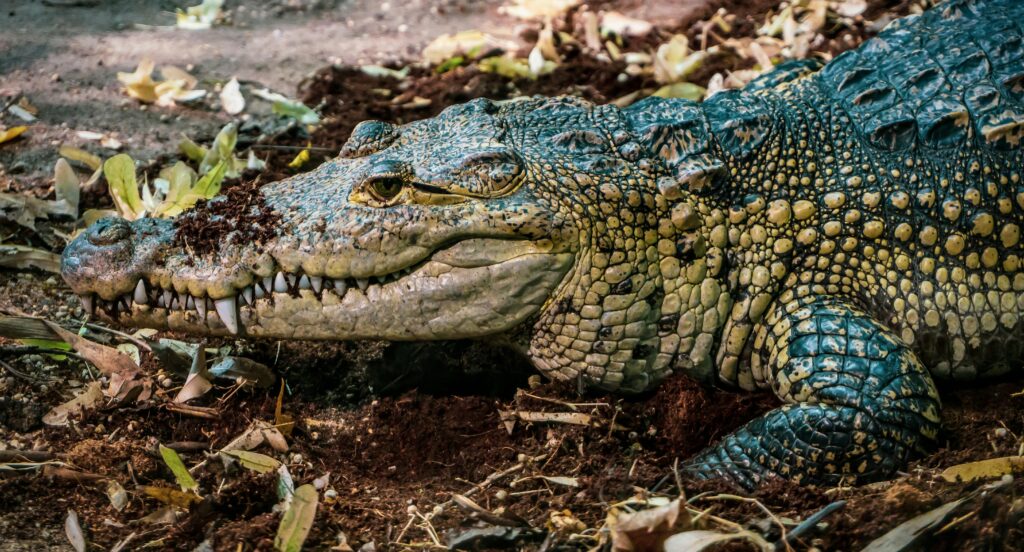In the seemingly ruthless world of the wild, the unexpected camaraderie of capybaras and crocodiles serves as a light of peace. These powerful rodents and terrifying reptiles manage to coexist, confounding traditional predator-prey relationships.
Nature conceals fascinating stories of coexistence and survival beneath each leaf and tree. One such story is about Capybaras and Crocodiles. Unpacking this relationship reveals the unexpected harmony that exists despite the volatility of the wild.
The Aquatic Marvel, Capybara
Capybaras are intriguing, large-sized rodents from South America. In biological taxonomy, Hydrochoerus hydrochaeris refers to an aquatic pig, which is appropriate given their semi-aquatic environment. Capybaras are approximately 1.25 meters long and 60 centimeters tall, and they unquestionably reign supreme in the rodent size hierarchy.
This size, however, is best understood by contrast. Capybaras’ massive size allows them to overpower a fully developed person, with weights ranging from 35 to 66 kilograms! They are, in fact, the gigantic cousins of guinea pigs, and they enjoy water just as much.
The Prehistoric Beast, Crocodile

Crocodiles, which may elicit both fear and excitement, are predators with a history dating back to the dinosaur era. These aquatic reptiles live in tropical climates near rivers, wetlands, and other freshwater habitats. Massive creatures can be found all throughout Africa, Asia, the Americas, and Australia.
The crocodile’s jaws are the distinctive feature of these aquatic behemoths, highlighting their formidable predatory abilities. It is not uncommon for them to spend their time languidly lurking beneath the waterline, with unwary victims coming too close and falling into the lethal trap of these hidden hunters.
Do Capybaras and Crocodiles Get Along?
The coexistence of capybaras and crocodiles is a fascinating phenomenon shaped by a number of factors that contribute to their ability to share habitats without always fighting. Let’s try to figure out “why do capybaras and crocodiles get along?”
Capybaras and crocodiles often cohabit in wetland habitats like rivers, lakes and marshes. These settings offer a wealth of resources for capybaras, including water and foliage, as well as a diverse range of prey for crocodiles.
1. Resource Partitioning
Both disciplines have evolved to make use of different features of their common environment. Capybaras are herbivores who mostly feed on water plants, whereas crocodiles are carnivores who hunt on fish and other animals. This nutritional differentiation limits direct food competition.
2. Social Behavior
Capybaras are highly social creatures that typically live in herds. This group activity offers them increased security from crocodile attacks because there are more people to recognize hazards and fend off predators.
3. Communication
Capybaras have an acute sense of smell and hearing, which allows them to detect the presence of crocodiles. Their attentiveness and vocalizations can act as early warning signs for the rest of the group, allowing them to avoid potential danger.
4. Cooperative Basking
Capybaras and crocodiles have been seen engaged in “commensal basking.” Capybaras occasionally sunbathe on the backs of crocodiles. This behavior may give Capybaras an advantage in detecting predators and staying warm while posing no threat to crocodiles.
5. Evolutionary Adaptations
Capybaras and crocodiles are thought to have developed together over time, acquiring habits and adaptations that lessen conflict. Natural selection may have favored both species since they were less likely to engage in deadly interactions.
6. Strategies for Avoiding Predators
Capybaras have developed techniques to prevent crocodile attacks, such as inspecting the water’s edge before entering and remaining close to escape routes. These measures lower the chances of becoming prey.
7. Environmental Factors
Changes in the environment, such as changes in water levels or vegetation, may have an affect on how they coexist. For example, a decline in water resources may lead to increased competition.
Are Capybaras Ever Preyed Upon By Crocodiles?
Despite their great size and apparent harmony with crocodiles, capybaras are occasionally preyed on by these reptile predators. Crocodiles, as opportunistic carnivores, may see capybaras as prospective prey, particularly when other food supplies are limited.
Several factors influence the risk of capybaras falling prey to crocodiles. To begin, crocodiles are patient hunters who often lie in wait along the water’s edge for an opportunity to strike. Because capybaras are semi-aquatic, they frequent water bodies to drink and forage, making them more vulnerable to ambush.
However, it is worth noting that such predation is not as common as one might think. To lessen the risk of crocodile attacks, capybaras have developed a variety of survival techniques, including group living and maintaining a great sense of smell and awareness. Furthermore, due to nutritional variations, capybaras are not the favorite prey of all crocodiles.
While capybaras are possible crocodile prey, their evolutionary adaptations and community dynamics help to lessen the risk, allowing them to coexist in the same settings as these fearsome reptiles.
How Do Capybaras Protect themselves from Crocodiles?
Despite their apparent peaceful coexistence with crocodiles, capybaras have evolved many techniques to defend themselves from probable crocodile attacks:
Capybaras are highly social animals that typically live in huge groups known as herds. This social system provides a high level of safety. When one capybara spots a crocodile or detects a threat, the entire group benefits. Crocodiles have a difficult time approaching undetected because of their collective alertness.
1. Sensitive and Vision
Capybaras have great senses, including keen vision and smell. They actively monitor their surroundings for signs of crocodile presence, particularly when approaching bodies of water. This high level of awareness allows them to spot crocodiles before it’s too late.
2. Communication
Capybaras communicate with one another using vocalizations like warning calls. When a capybara detects danger, it makes loud alarm calls that alert the rest of the group to the peril. This verbal communication increases their overall defense.
Can This Unique Relationship Be Disrupted by Environmental Changes?
Yes, environmental changes can damage the special bond between capybaras and crocodiles. Both skills require certain environmental conditions and resources to coexist. Environmental changes may have the following consequences for this relationship:
Fluctuations in water levels may affect the availability of suitable habitats. If water levels decline drastically, capybaras may have to relocate further away from water sources, making them more vulnerable to crocodile attacks.
1. Habitat Loss
Human activities such as deforestation and urbanization can cause habitat damage. This limits the number of habitats appropriate for capybaras and crocodiles, perhaps increasing competition for scarce resources.
2. Changes in Food Sources
Variations in the availability of aquatic vegetation or fish can influence the food choices of both species. If their primary food supplies become scarce, they may be forced to compete more fiercely for new food sources.
3. Climate Change
Temperature and weather patterns can alter the range of both species’ favored habitats. Warmer or drier conditions might alter the landscape and water sources, limiting their ability to coexist as previously.
Significant changes in their common environment could disrupt the delicate equilibrium between capybaras and crocodiles. While both species have exhibited adaptability, drastic environmental changes can result in more competition, fewer resources, and potential conflicts, disrupting their unique connection.
Conclusion
The continuous coexistence of capybaras and crocodiles is more than just a unique natural phenomenon. It’s a monument to the natural world’s complexity that seeing capybaras sunbathing peacefully beside crocodiles is just another unusual day in the animal realm.
Investigating the link between these two unusual species is not only vital for our understanding of them, but it also represents the potential for harmony in the most different and surprising of situations.




